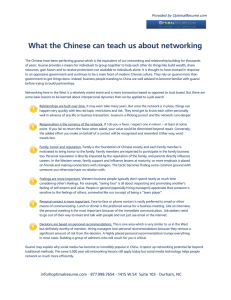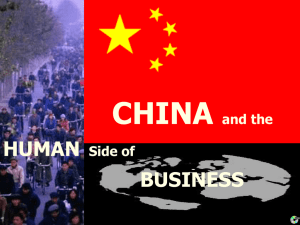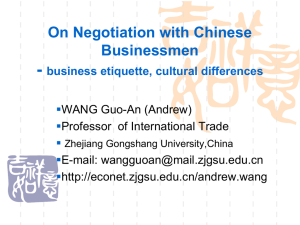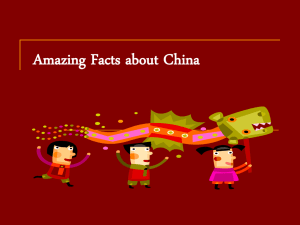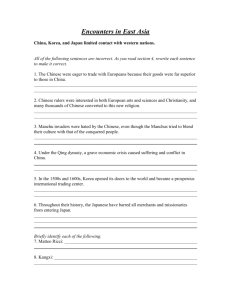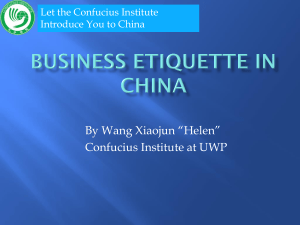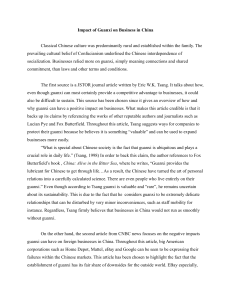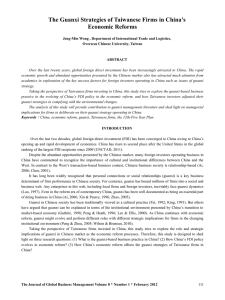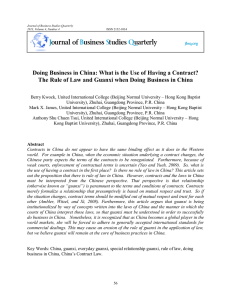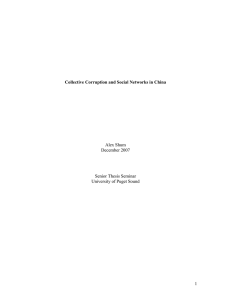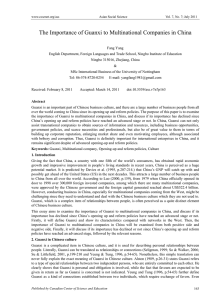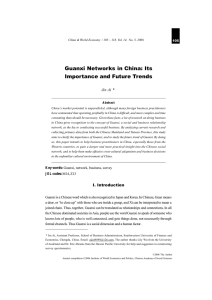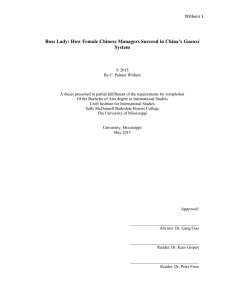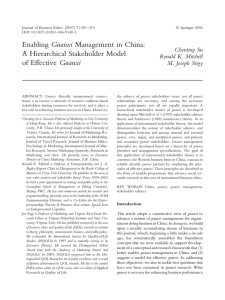International Business Culture
advertisement
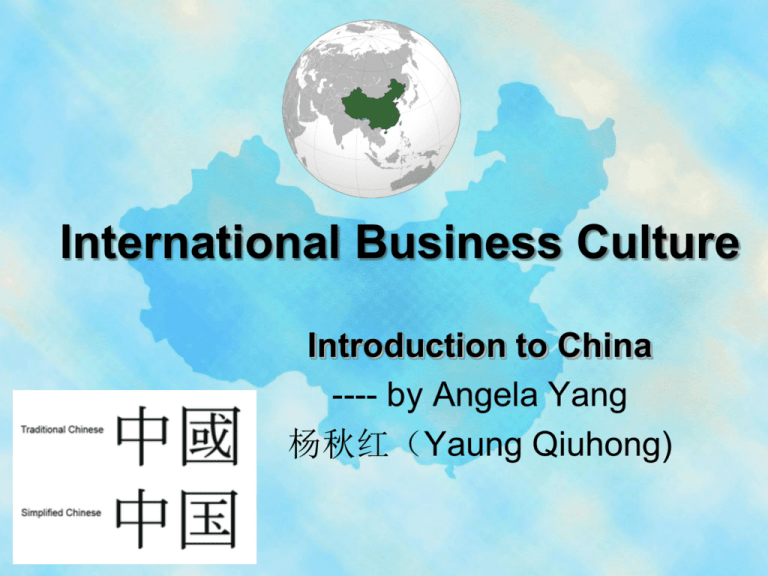
International Business Culture Introduction to China ---- by Angela Yang 杨秋红(Yaung Qiuhong) • When you are talking about China, what pop up to your mind? ●Urumqi ●Beijing ●Xian ●Shanghai ●Lhasa Guangzhou● 9,596,960 square km/3,705,392 square miles, Density:350/square mile 3,718,797square miles(USA) Density: 80 /square mile(USA) population Population: 1,321,290,000 (USA: 303,150,000) 56 ethnic groups/ The Han people make up 92% of the country's total population Former Vice Prime Minister Deng Xiaoping visited USA in 1979. It was the first time for PRC leader officially visiting USA President Hu Jingtao Prime Minister Wen Jiabao • Which of the followings are ancient Chinese invention? – Paper money – Compass – Clock – Gunpowder – Paper – The first seismoscope Some of the following English words originated from Chinese? Dim sum Lychee Won ton Ginseng Yam Chinese zodiac signs are important What animal sign were you born under? Chinese zodiac signs are important 1948 1960 1972 1984 1954 1966 1978 1990 1949 1961 1973 1985 1955 1967 1979 1991 1950 1962 1974 1986 1956 1968 1980 1992 1951 1963 1975 1987 1957 1969 1981 1993 1952 1964 1976 1988 1958 1970 1982 1994 1953 1965 1977 1989 1959 1971 1983 1995 China’s History Timeline Date Dynasty 2000-1500B.C. Xia 1700-1027B.C. Shang 1027-771B.C. Western Zhou 770-476 B.C Eastern Zhou 770-221B.C. Spring and Autumn 475-221 B.C. 221-207B.C. Warring States period Qin 206B.C.-A.D.9 Western Han A.D. 9-24 Xin A.D. 25-220 A.D. 220-280 Eastern Han Three Kingdoms The first prehistoric dynasty Thinkers and Philosophers Confucius, Lao Zi, Zhuang Zi and Sun Zi The first feudal autocracy Predominant ethnic group in China named after the dynasty Silk Roads China’s History Timeline Date Dynasty A.D. 265-316 Western Jin A.D. 317-420 Eastern Jin A.D. 420-588 Southern and Northern Dynasties A.D. 581-617 Sui A.D. 618-907 Tang A.D. 907-960 Five Dynasties A.D. 907-979 Ten Kingdoms A.D. 960-1279 Song A.D. 916-1125 Liao A.D. 1038-1227 Western Xia A.D. 1115-1234 Jin A.D. 1279-1368 Yuan the first government in world history to issue paper money China’s History Timeline Date Dynasty A.D. 1368-1644 Ming A.D. 1644-1911 Qing A.D. 1911-1949 Republic of China A.D. 1949 People’s Republic of China The last feudal dynasty Socialist society Part of Terracotta Army---The mausoleum of QinShihuang • The Silk Roads – Merchants traveling between China, Central Asia used overland routes. The most famous were called the Silk Roads. This network of routes eventually stretched from China over 4,000 miles to Mediterranean Sea, and linked China to India, the Middle East, and the Roman Empire. Silk Road Fundamental Beliefs and Values Confucianism Taoism Buddhism Social Structures Family Networks Ethnicity Relationship Rules Filial Piety Collectivism/ Face Trust and Reciprocal Hierarchy, Respect superior, Avoid direct conflict, Face is important, Guanxi, Family business, Perspective on Time, Negotiation on contract (Redding, G. 1990, The spirit of Chinese capitalism) Fundamental Beliefs & Values • Confucianism – First - family (or family clan); Second - community. The individual is unimportant. – Confucianism stresses the importance of avoiding conflict and emphasizes correct behavior – Confucianism is a social code based on morality rather than laws • Taoism – Wu-wei, or active not-doing • Buddhism – reincarnation Business Culture • China's ethical system involves respect for superiors, duty to family, loyalty to friends, sincerity and courtesy. • Age brings increased respect and status. • Hierarchy exists in organizations Conducts – Respect elders or superiors – Be modest, sincere and courteous Face • It is very important for Chinese people to "maintaining face" in everything they do. • The concept of shame and honor are more important in China than in US • Conduct – Never insult or openly criticize someone in front of others. Guanxi • “ Who you know is more important than what you know.” • What is guanxi? – Relationship – Connection – Network Guanxi does consist of connections, but more specifically of connections that are defined by reciprocity and mutual obligation. Various Levels of Guanxi Immediate Family Guanxi • How to build and maintain Guanxi? – Get intermediary – Get common ground with Chinese – Showing your interest in his/her experience – Showing your interest in his/her culture • Learn some mandarin • Study using chopsticks Guanxi How to build and maintain Guanxi? – In some cases, Guanxi may last for life with little or no maintenance. – For the western businessperson, the key is continued interaction. • • • • Gift-giving, entertainment at banquets,. Nurturing long-term mutual benefits Nourishing personal relationships. Cultivating trust Guanxi • The relationship you develop with a person represents your relationship with his or her entire company. • Guanxi is nurtured and maintained through relationships among individuals not organizations. Guanxi • There is some ethical issues or illegal issues existing in managing Guanxi. • In recent years, Wal-Mart, Lucent Technologies, IBM, Siemens, Carrefour, Diagnostic Products and Morgan Stanley have also been caught up in bribery scandals in China Family Business • • • • Family-directed operation The dominant family head Enduring roles and family obligations Very flexible in every aspect of business practice. Chinese perspectives • Signing a contract is not an end of the negotiation • Time is cyclical and elastic • Schedules should be changed to accommodate new circumstance • Short notice is acceptable Addressing Chinese • Family name comes first • Address a Chinese by surname with title President Hu, Chairman Mao, Director Lu • Skip vice, deputy and associate • Married women retain their maiden names. Gift giving • Don’t give a clock as a gift • Don’t give a green hat to a man as a gift • Some unlucky number should be avoided such as 4. Chinese lucky numbers are 6, 8 or 9 • Red represents prosperity and luck • Golden represents harvest and wealth • Generally white and black are not right color for wrapping gifts How to use chopsticks Rest one chopstick between your middle and ring fingers. Use your thumb to stable it. Rest the other one between your middle and index fingers. Also use the thumb to stable it Level chopsticks. Pick up the food with the only movement of the upper chopsticks, keep the lower one stationary at all time. Chopsticks Etiquette • Don’t point your chopsticks towards others • Don’t insert your chopsticks in the bowl upright • Don't beat your bowls while eating References • Tung, R. & Yeung, I., (1996) Aching business success in Confucian societies: the importance of guanxi(connections). Organizational Dynamics. • Redding, G,. (1990)The Spirit of Chinese Capitalism, Walter de Gruvter , New York • Chen, M.,(2001) Inside Chinese Business --- A guide for managers world wide, Harvard Business School Press • Dahles, H.& Wels, H. (2002) Culture , Organization and Management in East Asia: Doing Business in China, Nova Science Publishers, Inc. New York • http://en.wikipedia.org/wiki/China#Prehistory • http://en.wikipedia.org/wiki/People's_Republic_of_China • http://countries.pppst.com/china.html • http://www.chinavoc.com/history/index.asp
